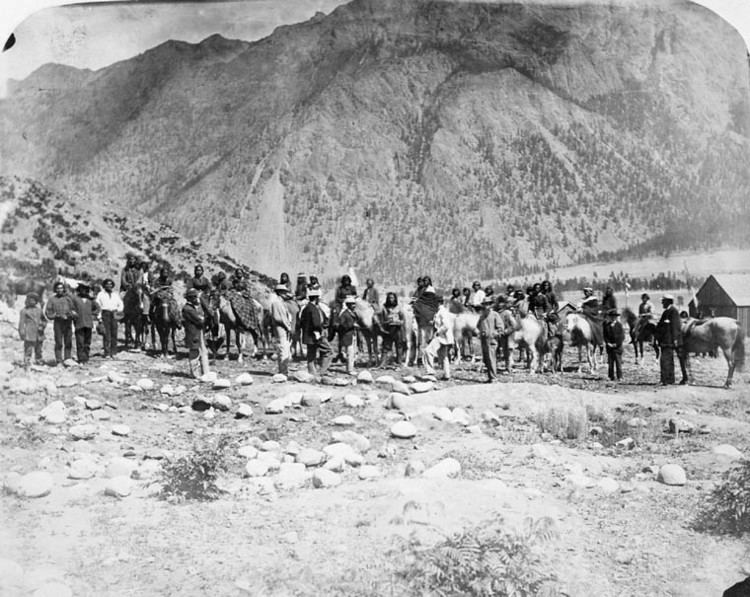 | ||
The St'at'imc ([ˈst͡ɬʼæt͡ɬʼemx]), also known as the Lillooet /ˈlɪlu.ɛt/, Sťáťimc, Stl'atl'imx /slætˈliːəm/, etc., are an Interior Salish people located in the southern Coast Mountains and Fraser Canyon region of the Interior of the Canadian province of British Columbia.
Contents
St'at'imc culture displayed many features typical of Northwest Coast peoples: the potlatch, clan names, mythology, prestige afforded the wealthy and generous, and totem poles in some communities, especially in the Lil'wat First Nation (Lil'wat7ul), whose tribal lands and trade routes in the Whistler Valley and Green River Vally overlapped with those of the Squamish First Nation, a Coast Salish people. Today they total about 6259.
Groups
The St'at'imc are divided linguistically, culturally and geographically into two main tribes or First Nations.
Lower St'at'imc
The tiny and remote communities of Samahquam, Xa'xtsa and Ska'tin Bands collectively, including the Tenas Lake Band, seceded from the larger Lillooet Tribal Council (now called the St'at'imc Nation) at the same time to join the N'quatqua First Nation at (D'Arcy) to form the In-SHUCK-ch Nation. Since the 1980s these First Nations called themselves Nsvq’tsmc ('In-SHUCK-ch micw'), derived from Nsvq’ts - 'split like a crutch', the name of the holy mountain, now called In-SHUCK-ch Mountain (also called Gunsight Mountain).
Upper St'at'imc
The tribal territory of the different groups of the Upper St'át'imc extended west of the Fraser River from the mouth of the Pavilion Creek (′Sk'elpáqs′) to the Texas Creek in the mountains above the Bridge River and westward through the valleys of Seton Lake and Anderson Lake to Duffey Lake. The territory of the Upper St'át'imc east of the Fraser River included the Three Lake Valley (also known as Fountain Valley) and the adjacent mountains and stretched towards the Hat Creek, a tributary of the Bonaparte River.
The Upper St'át'imc settled in several main settlements on the banks above the Fraser River and on the banks of the Seton and Anderson Lake — probably the word 'St'át'imc' is derived from a former village T'at'lh on Keatley Creek. Previous there were the following communities: Sk'ámqain on the shore of Seton Lake, Sat' at the site of present-day city of [Lillooet] [Lillooet (British Columbia)], Nxwísten at the mouth of the Bridge River, Xáxlip (′Fountain′), Slha7äs and Tsal'álh along Seton Lake and Nk'wátkwa on the western shore of Lake Anderson. Beside those significant settlements there have been several smaller villages. In Pavilion (Tsk'wáylacw), a mainly ethnically and linguistically Secwepemc settlement in the 19th Century, since the beginning of the 20th Century this community speaks usually St'at'imcets, but their particular dialect is a hybrid of St'at'imcets and Secwepemctsin, because there had been many mixed marriages between Secwepemc and St'át'imc, know forming the Tsk'weylecw'mc or Pavilion Indian Band.
History
They had several types of dwellings—long plank houses, winter earthlodges, and summer bark- or mat-covered lodges, not unlike those at the Keatley Creek Archaeological Site. Salmon and other fish were the basis of the economy, and numerous animals (bear, sheep, caribou, deer, and small mammals) were hunted and trapped, and berries and fruit were gathered. Warfare with other groups was unusual, with intensive intertribal trade the more typical state of affairs. Tsilhqot’in-St’at’imc war was one brutal war to the St’at’imc for their Survival as nation. The Tsilhqot’in to the St'at'imc were a raiding tribe, they raided all the 11 bands of the St'at'imc and took women and children as slaves. Both nations met at many roots (Graveyard Valley) in the St’at’imc territory which the St'at'imc were victorious. Chief In-Kick-Tee (Hunter Jack) was the warchief in that battle and made peace treaty in 1845.
Declaration of the Lillooet Tribe
The declaration of the Lillooet Tribe was made in 1911 in Spences Bridge and is the nation's declaration of ownership over lands that had been seized by non-native settlers at Seton Portage at onset of the 20th Century, and is considered a general statement of principle regarding ownership of all traditional territories of the St'at'imcets-speaking peoples. The Declaration of the Lillooet Tribe is the Lillooet Tribe's first formal declaration to the world of the tribes status as a Country, in International terms, as they understood them at that time. The Declaration is mentioned as the foundation document of all the various organizations of the Lillooet Tribe in place today, such as the St'at'imc Chiefs Council, Lillooet Tribal Council and the In-SHUCK-ch Nation. The Declaration brings the tribe together at the grassroots level as a Country.
Language
The ancestral language of the St'át'imc people is Lillooet (also known as St'at'imcets), a member of the Interior Salish group which includes the languages of the neighbouring Secwepemc (Shuswap) and Nlaka'pamux (Thompson) peoples.
